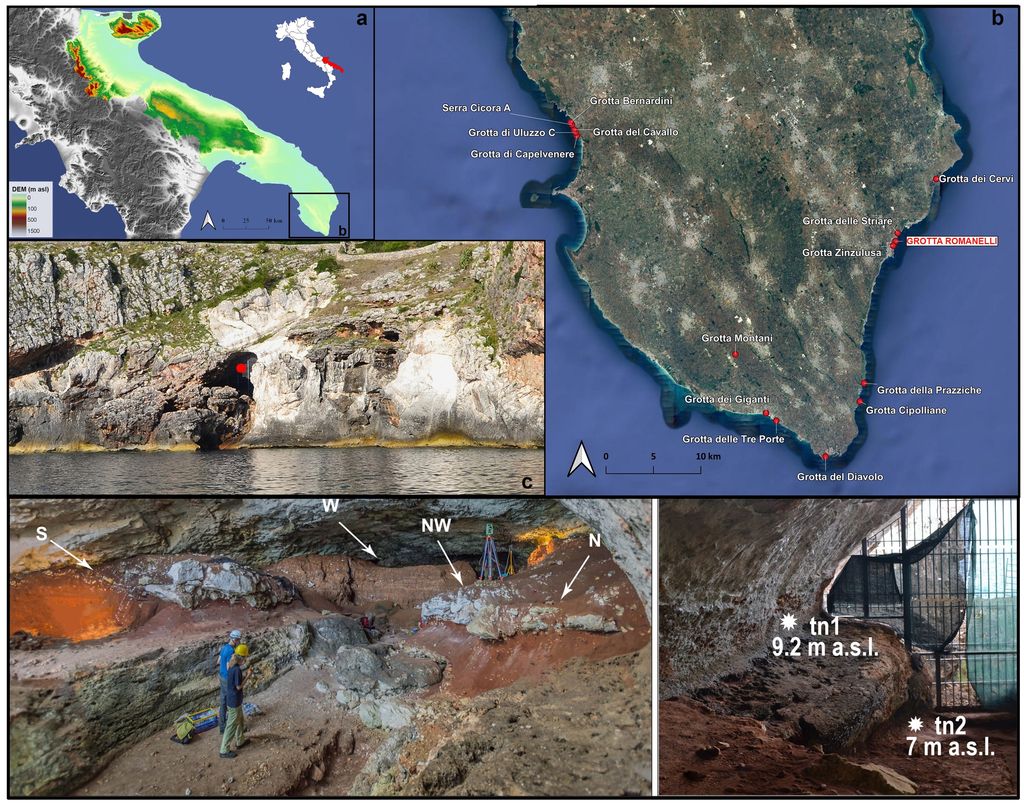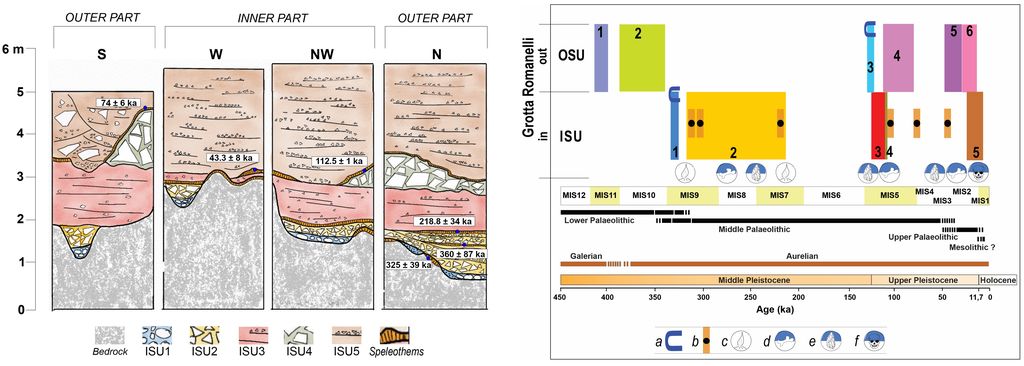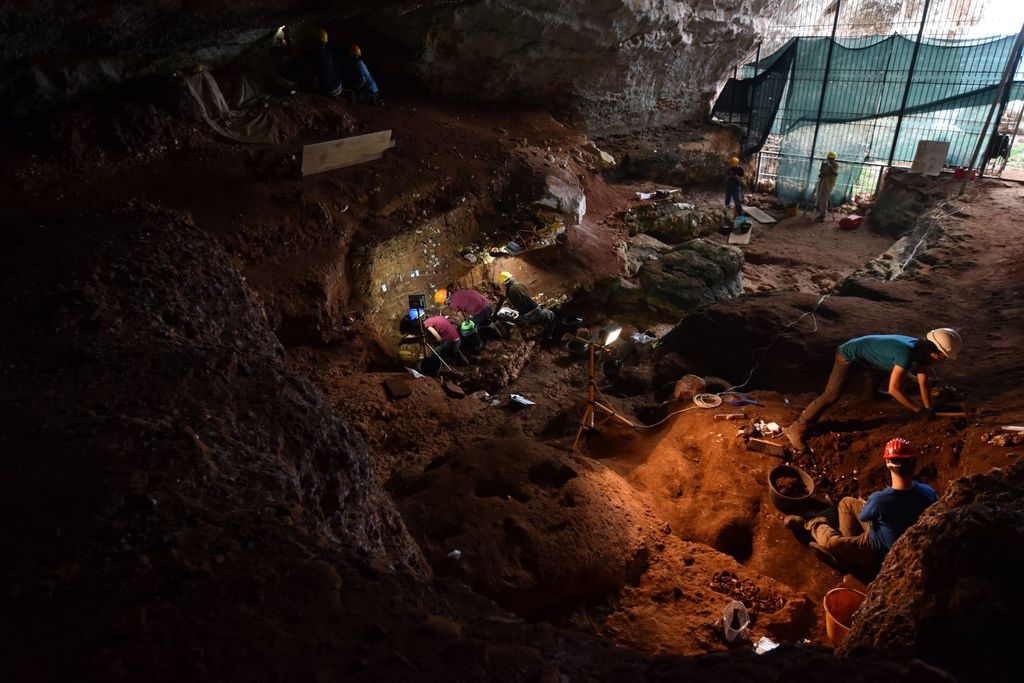
Neanderthal ancestors in Grotta Romanelli
The origins of the prehistoric site of Grotta Romanelli in Apulia, southern Italy, are much older than researchers have believed so far. The latest geological surveys and excavation activities have allowed the researchers to reconstruct the evolution of the cave, which began to fill up much earlier than previously believed, in a manner probably similar to that of other caves on the stretch of coastline in Salento under examination.
A study carried out by Sapienza, the University of Turin, the University of Milan, the Istituto di Geologia Ambientale e Geoingegneria of the National Research Council (CNR-Igag) and the University of Ferrara, authorised by the "Soprintendenza Archeologia, belle arti e paesaggio" for the provinces of Brindisi and Lecce and just published in the journal Scientific Reports, shows that humans and animals began to leave evidence of their presence in the cave sediments much earlier than indicated by past research.
The Grotta Romanelli site is an important archaeological and fossiliferous deposit from the Italian Palaeolithic period that has been an international reference point for the study of prehistory for over a century. Located in an inlet of the Salento coast near Castro (Lecce), the cave preserves traces of different phases of the passage of prehistoric people through numerous archaeological, palaeontological, human burial, wall and furniture artefacts.
The discoveries significantly change the reconstruction of the geological evolution of the area with important implications also for the history of sea-level variations and ecosystems in this sector of the Mediterranean.
The deposits at the base of the stratigraphic succession can be traced back to a sedimentary cycle, dating back some 350,000 years, instead of the 125,000 years (Tyrrhenian) believed so far.
In the lower layers, marine microfossils and stalagmite levels were brought to light, which, together with fossils of large mammals and limestone tools, made it possible to attribute the deposits to a period older than the Tyrrhenian. The dating was carried out in collaboration with the HISPEC laboratory in Taiwan.
The presence of humans in Italy long before the first Homo sapiens appeared is confirmed. This new stratigraphic picture, therefore, reinforces the idea that the humans who frequented the cave in the early days predate the Neanderthals.
New excavation and research activities are revealing an even richer and more articulated picture of the multiple elements of scientific interest of the Grotta Romanelli site. In the cave, there is evidence of different phases in the evolution of the Salento area, with the passage from ancient human forms, who lived with large mammals that later became extinct, such as elephants, hippopotamuses and rhinoceroses, to the presence of Homo sapiens in the upper part of the stratigraphic sequence and the artistic representations engraved on the vault of the cave.
Excavation activities on the ground will continue with the exploration of the innermost part of the cave, which has never been studied so far.
"A project that continues," concludes Raffaele Sardella of the Department of Earth Sciences at Sapienza University and project coordinator, "and that, in addition to new and numerous scientific discoveries, also intends to work on the valorisation and dissemination of the research of a site that, after more than a century, continues to tell fascinating and surprising stories.
|
Sapienza in Grotta Romanelli The first discoveries in the area date back to 1869, when Ulderigo Botti, following the discovery of fossils during an excursion to the nearby Capo di Leuca, hypothesised the presence of prehistoric people there since ancient times. It was only in the early 20th century that systematic research began, leading to the discovery of the cave by the palaeoanthropologist Ettore Regalia and the Salentine painter Paolo Emilio Stasi. After decades of excavations by various scholars, field activities came to a long standstill in the 1970s. Beginning in 2015, a multidisciplinary team, coordinated by Professor Raffaele Sardella of the Department of Earth Sciences at Sapienza University of Rome and funded by the Progetto Grandi Scavi, brought attention back to this site which still has many surprises in store. During past excavation campaigns, the site has yielded numerous lithic and bone artefacts, engraved stones, remains of wall art with geometric and zoomorphic compositions, as well as human bones referable to the final part of the Pleistocene. |
Image captions:
Figure 1 - Location of Grotta Romanelli and images of the internal excavation site. The asterisks indicate coastlines relating to different moments in the Pleistocene.
Figure 2 - On the left: stratigraphic sections of different cave sectors. On the right: a chronological diagram of the evolution of the cave in the Pleistocene.
Figure 3 - Evolution of the coastline in front of Grotta Romanelli during the Pleistocene.
Figure 4 - Excavation activities inside Grotta Romanelli. Photo by Luca Forti.
Figure 5 - Bay and entrance of Grotta Romanelli. Photo by Luca Forti.
Further Info
Raffaele Sardella
Department of Earth Sciences
raffaele.sardella@uniroma1.it









